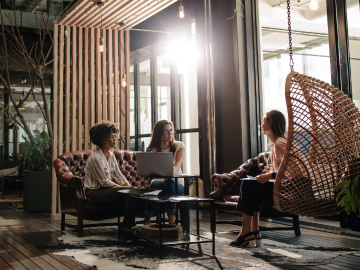In the modern workplace, collaboration is vital to success. Everyone understands that collaborative teams are more effective and more efficient. But that doesn’t mean every company is putting the right things in place for meaningful collaboration. Some are simply paying lip service, and it’s hurting their chances for success.
How to Futureproof Your Workplace in 8 Step
A practical guide to designing spaces that work for you and your people.
The workplace is changing, and employees are expecting more. Companies must work harder than ever to create inspiring and optimised workplaces that invite people in and compel them to interact, socialise, connect and share.
If you’re ready to take that step, download our new guide to uncover how we can help you prepare for and embrace the new era of work.
People working together, learning from each other and sparking new ideas is good for the individual as well as for the team. It reflects a culture that people who want to thrive can get excited about.
It also fills a void created by forced remote working, when so many people missed out on genuine interaction and the chance to freely collaborate. Companies now have an opportunity to get those behaviours back on track, to create truly collaborative workplaces that make efficient use of space and prevent siloed working from becoming the norm.
But it takes a commitment. It takes time and effort to understand what will make a tangible difference and how to optimise your workplace for success in a new era.
What is a collaborative workspace?
Great workspace design varies from place to place. For some companies, an open plan environment is ideal for bringing different people together to share ideas. For others, quiet areas give small teams the opportunity to explore or concentrate in the ways that suit them.
For a workplace to be truly collaborative, you must start with the goals of your business. How important is collaboration to achieving these goals? And what form should that collaboration take?
Hybrid working is now well established, but it’s become clear that people miss interacting with colleagues. JLL research shows 73% of people want to work from places that offer a destination for human connection, while 61% of the workforce crave ‘real’ human interactions with colleagues.
You have to differentiate the experience between home and office. Great workplaces should be equipped with critical elements to enhance work practices, like spaces designed with specific tasks in mind, where the atmosphere and tech makes the team want to work there
Harpreet Cheema, Head of Workplace Services, Sodexo UK & Ireland
Physical layout is vital, and the impact of one area on the effectiveness of others needs to be carefully considered - for example, where to position social spaces in relation to desks where people need to concentrate.
But truly collaborative spaces offer much more, incorporating technology that facilitates interactions and helps to create an atmosphere that supports your objectives.
Make your buildings work harder, not your people
Some of the benefits of more effective collaboration can be difficult to quantify, as it is partly about creating a sense of shared purpose and culture and improving the shared experience.
Others, however, are clearer cut. Reconfiguring a workplace to facilitate collaboration allows businesses to consider how their spaces and resources can be put to better use.
When Sodexo partner TSK conducted a space utilisation study for Sky Betting & Gaming, they found only 33% of the office was occupied at any one time, and only 44% of workstations were in use.
Of course, that didn’t mean they could do away with two-thirds of their office space. But any company can use such insight to identify how to make hybrid offices more efficient, and to reallocate resources so their buildings work harder for them.
This potential became apparent when Sodexo worked with leading investment and wealth management firm on the designs for a space spread over six floors. Having invested time in understanding the needs of the company and its people as they returned to the office post-lockdown, we advised reconfiguring the plans and relocating dining spaces.
The change freed up over 200 sq m of floor space that can now be adapted to facilitate new working practices, while creating more opportunities for interaction and collaboration in areas designed with that in mind.
Creating a collaborative space

Sky Betting & Gaming is a good example, as our partner TSK was able to take lessons from its space utilisation study when it considered how to meet the company’s long-term goals.
“We have always viewed in-person collaboration as an essential part of our success, an enabler of innovation and a contributor to our unique culture,” Sky Betting & Gaming CEO Steve Birch explained. “Our workplace is for our people and so any decisions we make must be right for them.”
With these priorities in mind, our partner TSK designed zones with unique character and functions, incorporating space for independent and collaborative work, as well as relaxation areas. Different areas had different functions, which would encourage people to leave their silos, move around and feel a greater sense of purpose.
A ‘tech bar’ provides a place for employees to learn more about the technology available to them and incorporated in the building, so they can make the most of collaborative workplace tools. This element is becoming increasingly important as companies experiment with new technology to facilitate collaboration between remote teams and those on-site, from digitally enabled meeting rooms to virtual reality workspaces.
Microsoft’s 2021 Work Trend Index found two-thirds of people would welcome new, more straightforward tools as they find remote collaboration more mentally challenging than in person. A future-proofed workplace needs to bridge this gap.
Committing to the future of workplace collaboration
A truly collaborative space improves retention, gives your teams a sense of purpose and creates a workplace buzz and an experience that cannot be replicated remotely. It helps people make connections that benefit everyone, and makes more efficient use of the resources and space available.
Utimately, designing and introducing a space fit for modern workplace collaboration takes a firm commitment, and insight into what will support the right kinds of collaboration among your team.
Without this understanding, you’re at risk of spending money on spaces that look great but are never used.
If you’re ready to take that step, download our new guide which offers practical insight on how to design the right space to bring the best out of your workforce.
Vital Spaces
Are you ready to commit to the future of workplace design?

